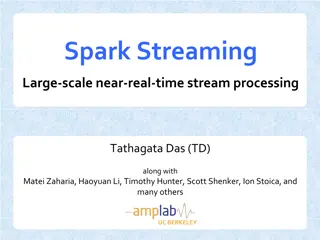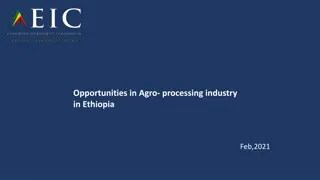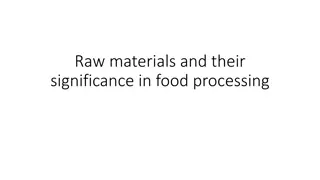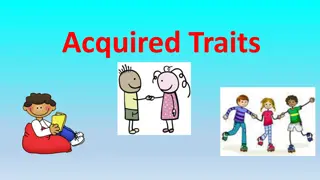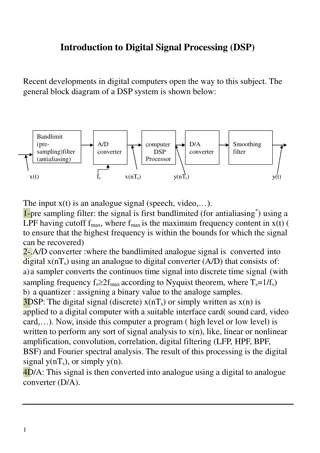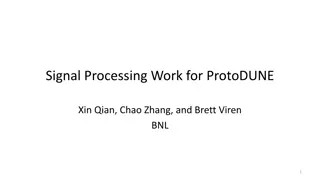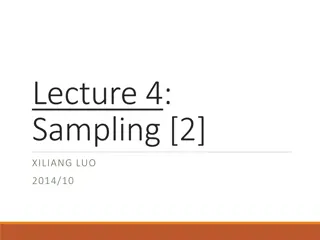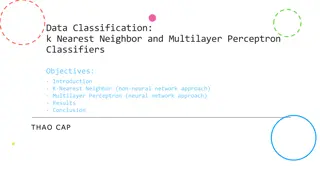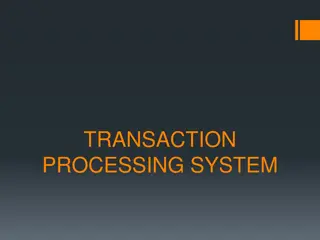Learned Feedforward Visual Processing Overview
In this lecture, Antonio Torralba discusses learned feedforward visual processing, focusing on single layer networks, multiple layers, training a model, cost functions, and stochastic gradient descent. The content covers concepts such as forward-pass training, network outputs, cost comparison, and parameter adjustments to minimize loss. The model training process involves selecting a cost function, passing inputs through layers, computing errors, and updating parameters via stochastic gradient descent. The goal is to optimize the overall loss function by iteratively adjusting parameters based on computed gradients.
Download Presentation

Please find below an Image/Link to download the presentation.
The content on the website is provided AS IS for your information and personal use only. It may not be sold, licensed, or shared on other websites without obtaining consent from the author.If you encounter any issues during the download, it is possible that the publisher has removed the file from their server.
You are allowed to download the files provided on this website for personal or commercial use, subject to the condition that they are used lawfully. All files are the property of their respective owners.
The content on the website is provided AS IS for your information and personal use only. It may not be sold, licensed, or shared on other websites without obtaining consent from the author.
E N D
Presentation Transcript
Antonio Torralba, 2016 Lecture 7 Learned feedforward visual processing
Tutorials Lunes: 4pm --> Torch Martes: 5pm --> TensorFlow Mi rcoles: 5pm--> Torch Jueves: 6pm ---> TensorFlow
Single layer network Input: column vector x (size n 1) Output: column vector y (size m 1) w1,1 w1,m Layer parameters: weight matrix W (size n m) bias vector b (m 1) Units activation: ex. 4 inputs, 3 outputs wn,m = + Output:
Multiple layers (output) xn Output layer n Fn(xn-1, Wn) xn-1 xi Fi(xi-1, Wi) Hidden layer i xi-1 x1 Hidden layer 1 F1(x0, W1) x0 (input) Input layer
Training a model: overview Given a training dataset {xm; ym}m=1, ,M, pick appropriate cost function C. Forward-pass (f-prop) training examples through the model to get network output. Get error using cost function C to compare outputs to targets ym Use Stochastic Gradient Descent (SGD) to update weights adjusting parameters to minimize loss/energy E (sum of the costs for each training example)
Cost function (output) xn Consider model with n layers. Layer i has weights Wi. Forward pass: takes input x and passes it through each layer Fi: xi = Fi (xi-1, Wi) Output of layer i is xi. Network output (top layer) is xn. Fn(xn-1, Wn) xn-1 xi Fi(xi-1, Wi) xi-1 x2 F2(x1, W2) x1 F1(x0, W1) x0 (input)
E Cost function C(xn, y) (output) xn Consider model with n layers. Layer i has weights Wi. Forward pass: takes input x and passes it through each layer Fi: xi = Fi (xi-1, Wi) Output of layer i is xi. Network output (top layer) is xn. Cost function C compares xn to y Overall energy is the sum of the cost over all training examples: Fn(xn-1, Wn) xn-1 xi Fi(xi-1, Wi) xi-1 x2 F2(x1, W2) x1 F1(x0, W1) y x0 (input)
Stochastic gradient descend Want to minimize overall loss function E. Loss is sum of individual losses over each example. In gradient descent, we start with some initial set of parameters Update parameters: k is iteration index, is learning rate (negative scalar; set semi- manually). Gradients computed by backpropagation. In Stochastic gradient descent, compute gradient on sub-set (batch) of data. If batchsize=1 then is updated after each example. Gradient direction is noisy, relative to average over all examples (standard gradient descent). If batchsize=N (full set) then this is standard gradient descent. 8
Stochastic gradient descend We need to compute gradients of the cost with respect to model parameters wi Back-propagation is essentially chain rule of derivatives back through the model. Each layer is differentiable with respect to parameters and input. 9
Computing gradients Training will be an iterative procedure, and at each iteration we will update the network parameters We want to compute the gradients Where 10
Computing gradients To compute the gradients, we could start by wring the full energy E as a function of the network parameters. And then compute the partial derivatives instead, we can use the chain rule to derive a compact algorithm: back-propagation 11
Matrix calculus x column vector of size [n 1] We now define a function on vector x: y = F(x) If y is a scalar, then The derivative of y is a row vector of size [1 n] If y is a vector [m 1], then (Jacobian formulation): The derivative of y is a matrix of size [m n] (m rows and n columns)
Matrix calculus If y is a scalar and x is a matrix of size [n m], then The output is a matrix of size [m n]
Matrix calculus Chain rule: For the function: z = h(x) = f (g(x)) Its derivative is: h (x) = f (g(x)) g (x) and writing z=f(u), and u=g(x): [p n] [m n] [m p] with p = length vector u = |u|, m = |z|, and n = |x| Example, if |z|=1, |u| = 2, |x|=4 h (x) = =
Matrix calculus Chain rule: For the function: h(x) = fn(fn-1( (f1(x)) )) With u1= f1(x) ui = fi(ui-1) z = un= fn(un-1) The derivative becomes a product of matrices: (exercise: check that all the matrix dimensions work fine)
Computing gradients The energy E is the sum of the costs associated to each training example xm, ym Its gradient with respect to the networks parameters is: is how much E varies when the parameter i is varied. 18
Computing gradients We could write the cost function to get the gradients: with If we compute the gradient with respect to the parameters of the last layer (output layer) wn, using the chain rule: (how much the cost changes when we change wn: is the product between how much the cost changes when we change the output of the last layer and how much the output changes when we change the layer parameters.) 19
Computing gradients: cost layer If we compute the gradient with respect to the parameters of the last layer (output layer) wn, using the chain rule: Will depend on the layer structure and non-linearity. For example, for an Euclidean loss: The gradient is: 20
Computing gradients: layer i We could write the full cost function to get the gradients: If we compute the gradient with respect to wi, using the chain rule: And this can be computed iteratively! This is easy. 21
Backpropagation If we have the value of we can compute the gradient at the layer bellow as: Gradient layer i-1 Gradient layer i
Backpropagation: layer i Layer i has two inputs (during training) xi-1 Fi+1 For layer i, we need the derivatives: xi Fi(xi-1, Wi) xi-1 Hidden layer i We compute the outputs Fi-1 Backward pass Forward pass The weight update equation is: (sum over all training examples to get E)
Backpropagation: summary E Forward pass: for each training example. Compute the outputs for all layers C(Xn,Y) (output) xn Fn(xn-1, Wn) xn-1 Backwards pass: compute cost derivatives iteratively from top to bottom: xi Fi(xi-1, Wi) xi-1 x2 F2(x1, W2) x1 Compute gradients and update weights. F1(x0, W1) y x0 (input)
Linear Module Forward propagation: xout F(xin, W) xin With W being a matrix of size |xout| |xin| Backprop to input: If we look at the j component of output xout, with respect to the i component of the input, xin: Therefore: 25
Linear Module Forward propagation: xout F(xin, W) xin Backprop to weights: If we look at how the parameter Wij changes the cost, only the i component of the output will change, therefore: And now we can update the weights (by summing over all the training examples): (sum over all training examples to get E) 26
Linear Module xout Weight updates xin
Pointwise function Forward propagation: xout F(xin, W) xin h = an arbitrary function, bi is a bias term. Backprop to input: Backprop to bias: We use this last expression to update the bias. Some useful derivatives: For hyperbolic tangent: For ReLU: h(x) = max(0,x) h (x) = 1 [x>0]
Pointwise function xout Weight updates xin
Euclidean cost module C xin y
Back propagation example node 1 node 3 w13=1 1 tanh 0.2 node 5 output input linear -3 node 2 node 4 -1 1 tanh Learning rate = -0.2 (because we used positive increments) Euclidean loss Training data: input desired output node 5 node 1 node 2 1.0 0.1 0.5 Exercise: run one iteration of back propagation
Back propagation example node 1 node 3 w13=1 1 tanh 0.2 node 5 output input linear -3 node 2 node 4 -1 1 tanh After one iteration (rounding to two digits): node 1 node 3 w13=1.02 1.02 tanh 0.17 node 5 output input linear -3 node 2 node 4 -0.99 1 tanh
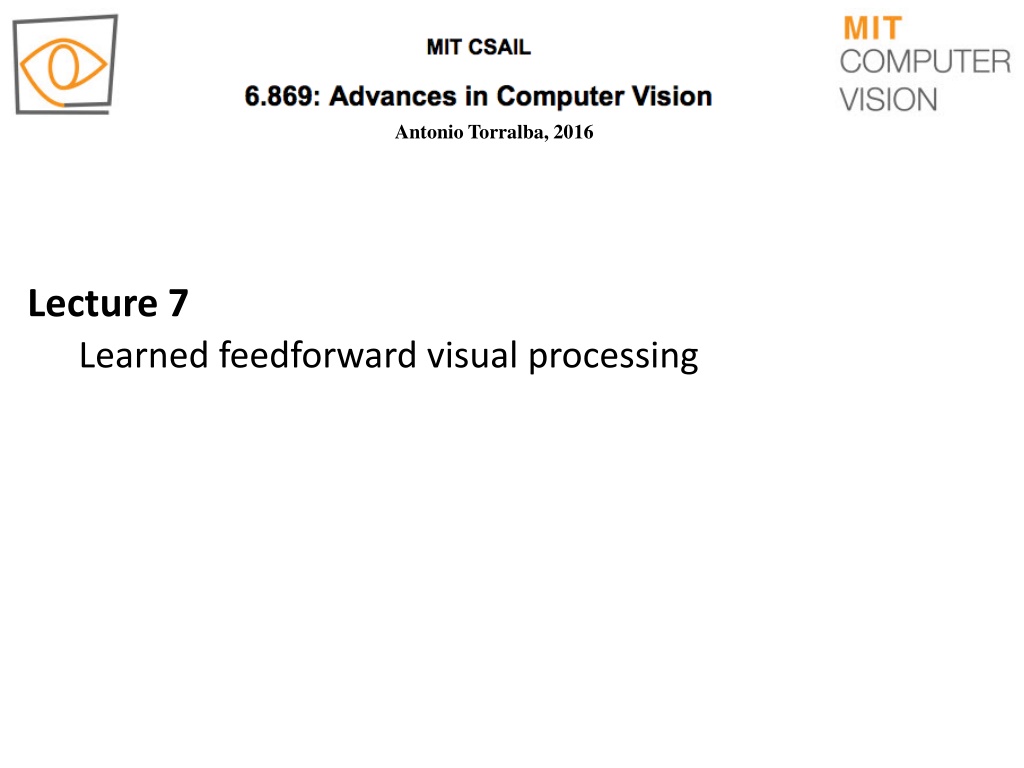


![textbook$ What Your Heart Needs for the Hard Days 52 Encouraging Truths to Hold On To [R.A.R]](/thumb/9838/textbook-what-your-heart-needs-for-the-hard-days-52-encouraging-truths-to-hold-on-to-r-a-r.jpg)

